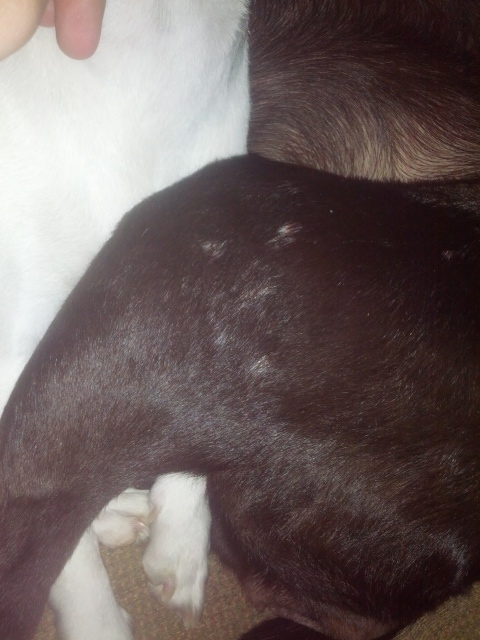QuestionQUESTION: For the city's animal shelter I'm fostering a momma cat and her 4 kittens. When the kittens were 6 days old the mom developed ringworm and I realized she also had ear mites. The shelter treated the ear mites and gave me an anti-fungal cream for her small spot of ringworm. Within 3 wks the kittens had the ringworm as well. The momma cat's first area of infection is almost back to normal, however she continues to come up with new spots which I then begin treating with the cream. So do the kittens. Now the shelter is talking about maybe having to euthanize the whole bunch. I'm headed that way to pick up an oral med (Ketoconazole) for the mom, and a bath liquid for the kittens, but they say the kittens could get liver damage and other problems if they took the oral med at this age (6 wks old now). I'm open to any and all suggestions on how to get this under control and stop the reinfection. Should I separate Mom and kittens? (they still nurse some but some of them are eating the kitten chow too) I'm in the process of spring cleaning their original area (bedroom with carpet), and have them currently in a large master bath (also with carpet). I've invested a total of 9 wks on Mom and her babies and the last thing I want is to see them all put down. :( HELP PLEASE! Thank you.
ANSWER: They don't always need to use the oral medication when they are so small if you do scrubs with betadine on them and then treat the patches with cream. The problem with ringworm, however, is that they can become silent carriers of it, and it will erupt now and then throughout their lives.
The mom should be on the oral med, usually Griseofulvin, but without having a bottle of it in front of me, I don't know the age limit on giving it.
You might want to look over this article on ringworm in cats and decide what is best:
http://www.marvistavet.com/html/body_ringworm.html
It goes into every treatment available and the side effects.
I would separate the kittens from the mom so she can get over this infection. In that way, she would stop reinfecting the kittens. We have had good luck treating kittens with dips, or scrubbing the areas with betadine and then using a ketoconizole cream on the patches. I use Lomatril when I need to for this as it is a stronger antifungal, but you can use the generic fungal cream from Wal mart as well. Scrubbing the patches medium hard with a wetted cotton gauze sponge and the betadine is a good way to get it into the skin where it can kill the fungus. A 6 week old kitten can handle that well. You can get the sponges at the pharmacy or ask the vet for a package of them.
Of course if you don't have a say over what happens to these kittens and the mom, you need to prepare yourself for that. While it is a wonderful thing that you are doing, the very act of caring for shelter animals can lead to some very painful moments. I applaud you for what you do, and feel the pain you will feel if this group is put down. I guess you have to think in long term for their own health and comfort.
If you are persistent and read this article and follow it, you can lick this. Good luck and please let me know how it goes with all of them.
---------- FOLLOW-UP ----------
QUESTION: Just an update. Kittens are much improved with the med. bath and spot-treating. Mom's doing better although she's getting to where she doesn't want to eat the canned cat food with the crushed up 1/4 pill (Ketoconazole)in it. They say it has to be ingested with fat/oil for it to get into the skin.?? I gave her the pill by itself successfully yesterday but she got no extra oil. Should I try giving the pill then providing some canned catfood in hopes that it was just the taste that was bothering her?
Have been unable to separate Mom & kittens due to logistics and no other help forthcoming from the other volunteers with the shelter. Have seen no new lesions in 4 or 5 days now and fur is regrowing on most spots.
And of course they all seem to "feel" fine, jumping, playing as they always have. That never changed. One kitten who didn't show infection signs until 2 wks after the first 3, is the farthest behind in recovery. Do they develop their own anti-bodies over time after exposure? Thanks, Sheila
ANSWER: Most cats do develop an immunity to ringworm and are usually immune for life once they get over it. Kittens are going to take longer to get over it and develop this immunity.
Yes the taste will be gross. Give her the pill then give her the food right afterward. Ketoconazole is bitter.
Glad to hear that they are doing bet
ter. Keep it up and you will lick this!
---------- FOLLOW-UP ----------
QUESTION: Just to clarify, in your first reply you mentioned Lomatril. I can't find that anywhere. It only comes up with 3 hits on google, one of which is ours from this run of questions/replies. Is it possible you meant Lotrimin? That is the brand name for the generic cream (active ingredient Clotrimazole)I've been using from WalMart. I also have Terbinafine, and the Animal Welfare vet initially gave me a small tube of Miconazole cream, which didn't seem to be working so I quickly switched to the Lotrimin/Clotrimazole. Two of the kittens still seem to be struggling despite the Lotrimin cream (and med. bath) and I'm wondering if I should shift to one of the other creams in case the fungus may be becoming resistant?? Thanks.
AnswerWhile I am not sure they can become resistant this fast it is always good to switch things up if one isn't working.
Yes I meant Lotrimin but was really tired when I wrote you back! Thanks for finding that boo-boo.
Miconazole is probably the weakest of the bunch but it is also what kills most of the yeast and fungus infections so it's sold a lot.
Give the other one a try and you might want to change up the medicated scrubs as well. Have you used any betadine scrub yet? It really kills that stuff fast.
Just spot scrub the areas affected, do not bathe the whole kitten in it.
Scrub with a cotton sponge and then rinse it a bit then dry it and put the cream on it.
That's how we use it at the vets.

 Chanel
Question
Chanel
I had a miniature pinscher of 8
Chanel
Question
Chanel
I had a miniature pinscher of 8
 sick little puggie
Question
lola
My year old chug (chihuahua pug cr
sick little puggie
Question
lola
My year old chug (chihuahua pug cr
 dog breathing heavily through nose
Question
Camo Camo
Hello, I have a male Am
dog breathing heavily through nose
Question
Camo Camo
Hello, I have a male Am
 Coco: itching, scratching, biting
Question
Coco outter thigh Coco tail
I hav
Coco: itching, scratching, biting
Question
Coco outter thigh Coco tail
I hav
 kitten not using litter box, but sleeps in it
QuestionHi. We just got a new kitten. It is 9 weeks old
kitten not using litter box, but sleeps in it
QuestionHi. We just got a new kitten. It is 9 weeks old